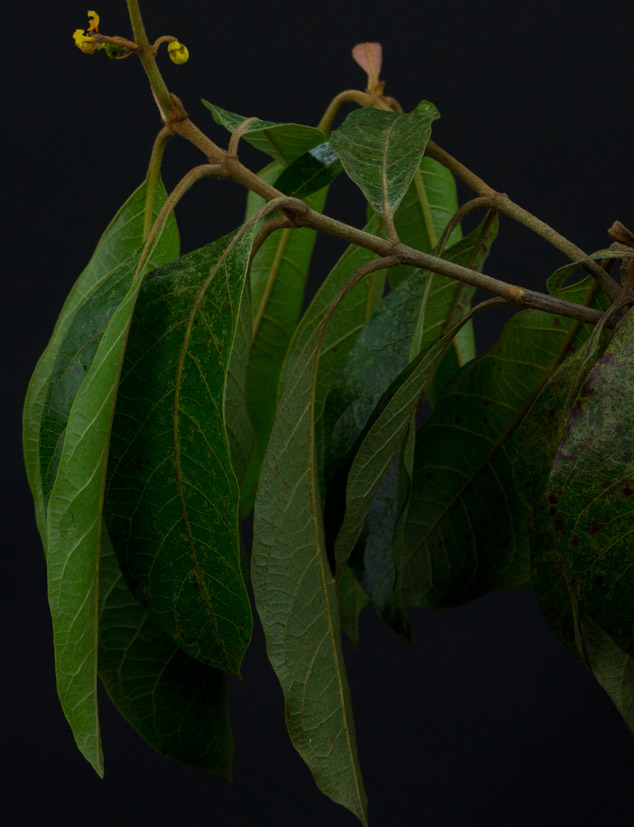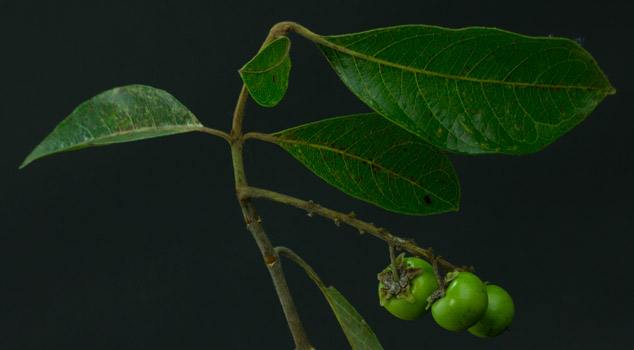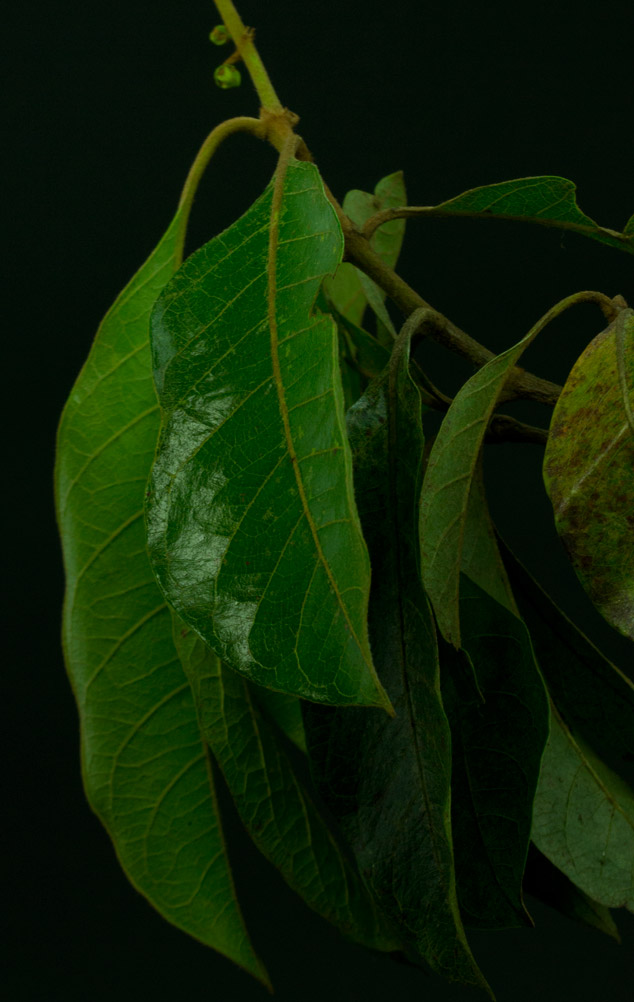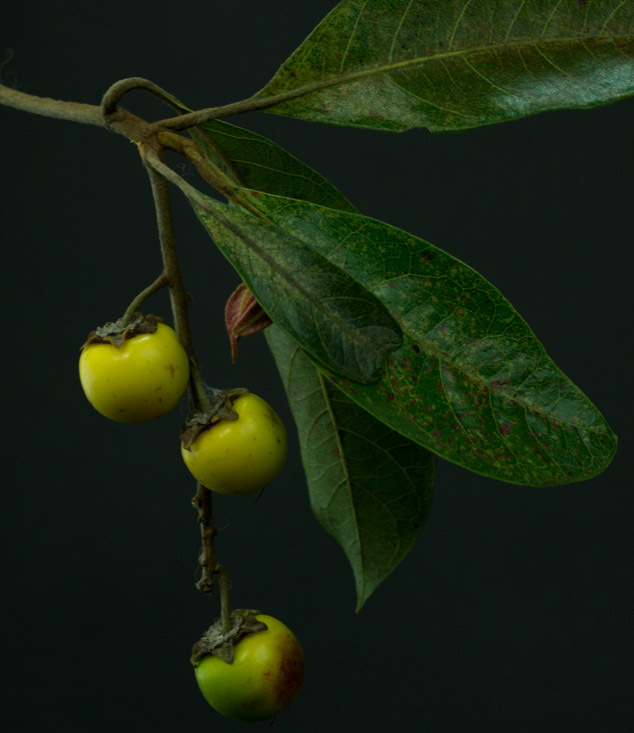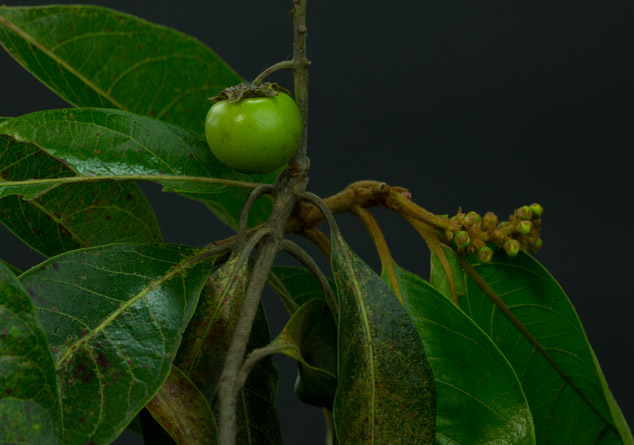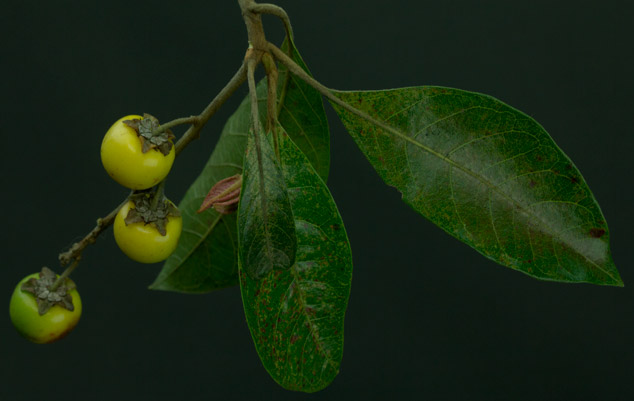Tobacco wrapped in several different leaves
Thompson mentions cigars wrapped in nance leaves: I found the same while doing research on the Cholti-Lacandon, circa 1695. Fuentes y Guzman also mentions leaves of guayabo, Psidium guajava.
Practical uses, other than symbolic
Like hundreds of other plants, there are medicinal uses of the nance tree bark and leaves. The branches can stupefy fish when the branch is cut and thrown into the water; the bark can be used to tan leather; unripe fruits can dye cotton a light-brown. (www.hort.purdue.edu/newcrop/morton/Nance.html), A liquor of nance is made in several countries: in Mexico and in Central America (Wikipedia).
Medicinal uses of nance tree bark or fruit
Breedlove and Laughlin 1993:151
List of species of nance trees in the Mesoamerican area
Byrsonima crassifolia
In Peten several Peteneros said there are three kinds of nance
- Yellow, acidic fruit; but birds eat it; small birds. But also parrots and potentially macaws.
- Yellow, sweet edible fruit.
- Red, sweet edible fruit.
In several hours of web surfing I did not find any botanical discussion of three different kinds of fruits. This raises the question of whether the fruit’s acidity depends on particular factors in the environment. The change in color may also depend on environmental factors. The article in Nance of Nayarit area, Mexico might be one direction for future research, realizing however that Nayarit is not the same climate as the Maya areas.
Common names
Yellow cherry
The fruits of a number of species of Byrsonima have been consumed by the Indians of Central America and northern South America. The best-known of these is the nance, B. crassifolia HBK. (syns. B. cubensis Juss.; Malpighia crassifolia L.), which has acquired many alternate vernacular names: changugu, chi, nance agrio, nanche, nanchi, nancen, nanche de perro, nananche, and nantzin in Mexico; nance verde in El Salvador; nancito or crabo in Honduras; craboo, crapoo and wild craboo in Belize; doncela and maricao in the Dominican Republic; maricao cimaroon, maricao verde, peralejo and peralejo blanco in Puerto Rico; peralejo de sabana in Cuba; tapal in Guatemala; chaparro, chaparro manteca, maache, mantequera, nanzi, noro, peraleja hembra, yaca or yuco in Colombia; chaparro de chinche, chaparro de sabana, manero manteco, manteco merey or manteco sabanero in Venezuela; murici, mirixi, murici-do-campo, and muruci-da-praia in Brazil; hori, sabana kwari moeleidan, and sabana mango in Surinam; huria in Guyana; quinquina des savannes in Guateloupe; savanna serrette in Trinidad; sometimes wild cherry in Panama; golden spoon in the former British West Indies. (www.hort.purdue.edu/newcrop/morton/Nance.html).
Nance in local Mayan languages
Chi’. Nance, Yucatec
Chi, Chol (Berlin, www.wayeb.org/download/resources/berlin01.pdf
Chi, Kekchi
Notable that nance is pretty much the same word in all three languages, albeit all three are Lowland, though Kekchi is partially Highland.
In several other languages it is chap or cha’p; in several Highland languages it is tapa'l.
The scanned version of the Tzotzil dictionary of Robert Laughlin is such inadequate scanned resolution that the somewhat overly scholarly linguistic symbols are illegible. This is a good case of how “too much of a good thing” is not very helpful. We also scan old books, and we are aware it is not easy to get a good version. But surely someone could have done better than this.
Other interesting plants in the same family
Habitat of nance trees in the Mesoamerican area
Most botanical sources mention the dry savanas as the main habitat where Nance can be found. It would be interesting to see if Nance is found in the Quiche Highland area of Guatemala. Most of the savanas with Nance are in Peten (the lowlands). Sharer and Sedat (page19) also list the nance tree has present in the Valley Floor Dry Scrub Forest in the Salama Basin (Baja Verapaz).
A MA thesis on the Soconusco area of Chiapas, Mexico (Feddema 1993:11) indicates that nance trees are found in the savanna area there (Mirando 1952: Miranda and Hernandez X 1963).
Nance trees are included in gardens around the houses in Puuc area of Yucatan (Smith and Cameron 1977).
Nance uncovered in archaeological excavations
“Nance tree seeds were found in about 40% of the samples taken” at Cerros archaeological site, Belize (Wikipedia.org; Googled from nance tree Maya).
Summary
There are so many errors and misidentifications when Maya archaeologists and ethnographers attempt to identify plants. J. Eric S. Thompson is the best example, especially his discussion of the flower which be was convinced was the model for the Kin, sun hieroglyph. The Plumeria rubra has 5 petals; the kin glyph has 4 petals. You could spend weeks listing the endless other scholars who naively believed Thompson and repeated the same assertion.
Now I notice that either Thompson (or someone he is citing) is claiming that the leaf of the plant used to wrap the cigars of the Cholti Lacandon in the 17th century was Malpighia glabra. I did research on these Cholti Lacandon in 1971, in the Archivo General de Central America in Guatemala City, and in the Archivo General de Indias, in Sevilla, Spain. Plus I worked with documents in the Peabody Museum (collected by Scholes). I would have to trust my memory of over 42 years ago (my notes from these years are stored in Austria for over 25 years). But I firmly remember the name of the plant was clearly listed as nance, and even clearly stated as being a plant from the savanna (or I did research and found the plant was from savanna area).
So to read that Thompson claims the plant was Malpighia glabra is the most unexpected ethnobotanical error I can imagine. This Barbados cherry is native to Mesoamerica despite its name, so would have potentially been native to the Cholti-Lacandon people.
Bibliography: Monographs on Nance trees or fruits of Mexico, Belize, Guatemala, Honduras, El Salvador, and Costa Rica
- 2007
- Trees in the Life of the Maya World. BRIT Press, Botanical Research Institute of Texas.
- 2008
- The Encyclopedia of Fruits and Nuts. CABI. 800 pages.
- 2003
- A Preliminary Mayan Etymological Dictionary. On-line. Over 1500 pages.
- 1997
- A Neotropical Companion: An Introduction to the Animals, Plants, and Ecosystems of the New World Tropics (2nd ed - 1999), Princeton University Press, 451 pp.
- Vegetation of Peten. Carnegie Institution of Washington.
- 1987
- Fruits of warm climates. Julia F. Morton, Miami, FL. Nance is mentioned on pp. 207–209. In:
- 2012
- El dulce sabor del nance: préstamos lingüísticos del cholano al Yucatecano. V. Coloquio Leonardo Manrique (2012) Instituto Nacional de Antropología e Historia.
- 2003
- Ancient Mesoamerican Warfare. AltaMira Press, 384 pages.
- 1987
- Archaeological investigations in the northern Maya Highlands, Guatemala. University of Pennsylvania Press. 487 pages.
- 2005
- Guatemala Arboles mágicos y notables. Artemis Edinter Editores, Guatemala.
- 2004
- Fruit Quality Indices in eight Nance [(Brysonima crassifolia (L.) H.B.K.] Selections. HortSciece, vol. 39, no. 5, pp, 1070-1073. American Society for Horticultural Science.
- The Myth of Quetzalcoatl, JHU Press
- 2007
- Popol Vuh: The sacred book of the Maya. University of Oklahoma Press. 328 pages.
- 1993
- Page 151 mentions nance is used to treat tooth pain.
- 1977
- Ethnobotany in the Puuc, Yucatan. Economic Botany 31:93-110.
- 2004
- Rituals of sacrifice: walking the face of the earth on the sacred path of the Sun. University of New Mexico Press. 330 pages
- 1993
- Early Cormative Subsistence and Agriculture in Southeastern Mesoamerica. MA Thesis, University of British Columbia, Dept of Anthropology and Sociology.
Has only one terrible photo of a nance tree (p. 65). This photo is a good example of a snapshot that should not have been enlarged to attempt to decorate a page in a coffee-table book. This image was probably not good at a smaller size either.
Books that mention the nance tree but only in passing
Mentions nance tree with no further comment on page 19. This book covers archaeological research in the Salama Valley.
Pertinent articles on Nance trees or fruit of Mesoamerica
Pertinent articles that discuss or picture artifacts that show Nance trees or fruit
Pertinent web sites on Nance trees or fruit of Mesoamerica
www.backyardnature.net/yucatan/nance.html General comments by Jim Conrad and has many good-sized nice photographs of the flowers and initiation of the fruit from the flowers.
www.forestgeneration.com/nance-tree.html One page general description of nance tree, but with no particular orientation to its habitat specifically in Guatemala. Has a few small photographs.
http://ntsavanna.com/nance-in-bloom Nice photographs of nance tree flowers and general information. Includes an excellent close-up of a single flower.
www.mayacodices.org/searchWiz.asp search engine for Madrid Codex.
www.hort.purdue.edu/newcrop/morton/Nance.html Basic scientific information; minimal photos; not updated since 1999. But since it has a sentence on every aspect, the report is nonetheless worthwhile (though it lacks a bibliography other than Morton 1987). In effect, there is a need for more modern information.
http://usaid.fiu.edu/Marketresearch/4/group5.pdf A market survey of summer 2008 by US AID on whether it is worthwhile trying to export Nance fruit to the US. Main use is its bibliography of a dozen web sites.
Botanists who specialize in Nance trees or fruit
Pertinent bibliography on Nance trees or fruit in Mayan hieroglyphic writing
Pertinent illustrations or discussion of Nance trees or fruit in Maya iconography or as archaeological artifacts
Suggests the tree on Izapa Stela is a nance tree. But unfortunately the fruits on this Izapa tree are of the size, shape, and location that would be typical of a morro or jicara tree, and not a nance at all.
Pertinent Ethnohistory and Ethnography
Page 190 discusses the nance tree. This book is on the Tz'utujil Maya people of Santiago Atitlán.
Dictionaries of Mesoamerican Languages with references to Nance trees or fruit
Flora Maya Dictionary
www.manana.cz/slovnik/rostlin_en.php?&serad=latin_ros
Theses or dissertations on Nance trees or fruit of Mesoamerica or related iconography or archaeology
First posted April 1, 2013.


